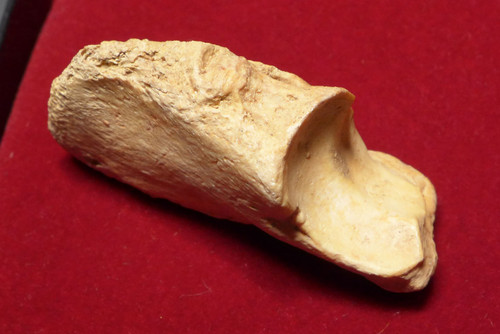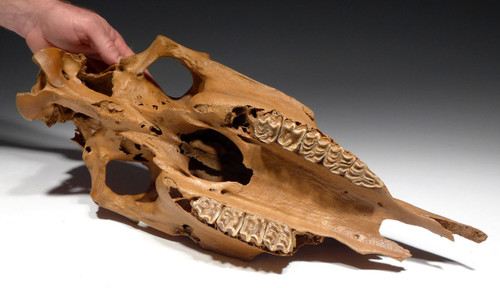Product Description
From a private American museum collection dating to nearly 20 years ago, we offer this amazing rarity - a complete and perfectly preserved fossil hoof of an Ice Age Ibex (Capra ibex). It was found in the Carpathian Mountains in a cave deposit layer that also included Cave Bear remains. It shows stunning preservation with with the classic light color known for all cave fossils from this region.
HISTORY
The Capra ibex is a wild mountain goat that thrived during the Ice Age in Europe. It is one of the most famous animals depicted on numerous cave drawings and paintings. No doubt, with its exotic and impressive horn display and unmatched skill in climbing rocky terrain, it was a revered and respected beast by prehistoric humans. This animal possessed very large curved horns with pronounced ridges running across the full length of these horns. They were stout beasts with short legs and hooved feet that were especially designed for irregular terrain. These creatures are alive today in limited regions and are called the Alpine Ibex. They thrive in the most extreme and hazardous environments, consisting of arctic-like temperatures and seemingly impossible to navigate rocky mountain faces. Even today, very little is known about these animals because their habitat is practically unreachable by scientists for study. Aside from their magnificent horns, their hooves are uniquely designed to maintain a sure footing on rock.
Capra ibex live in herds from 7 to 30 individuals with some males living alone. They are diurnal animals meaning they are active during the day, with their most active periods being early morning and late afternoon. Their height at the shoulders range from 2.3 to 3.1 feet. Body weights range from 88 to 264 pounds. Horn lengths have been measured up to 40 inches. Life spans run from 10 to 14 years.
The Capra ibex has an uncanny ability to negotiate the most dangerous rock cliffs and ledges with seemingly careless abandon.
 US DOLLAR
US DOLLAR
 EURO
EURO
 AUSTRALIAN DOLLAR
AUSTRALIAN DOLLAR
 CANADIAN DOLLAR
CANADIAN DOLLAR
 POUND STERLING
POUND STERLING




















